
Ceratomia amyntor, the elm sphinx or four-horned sphinx, is a North American moth in the family Sphingidae. The species was first described by Carl Geyer in 1835. It has a wingspan of 3+1⁄4-4+1⁄2 inches. As the name suggests, the larvae (caterpillars) feed on elm trees (Ulmus), but they can also be found feeding on birch (Betula), basswood (Tilia), and cherry (Prunus). When the caterpillars are ready, they crawl to the bottom of the host tree, where they crawl underneath the soil and pupate and may overwinter underground if late enough into the year. Vegetable growers should be aware of this larvae due to its insatiable appetite. One of these larvae are capable in devouring huge amounts of plant's foliage and even succulent stems.
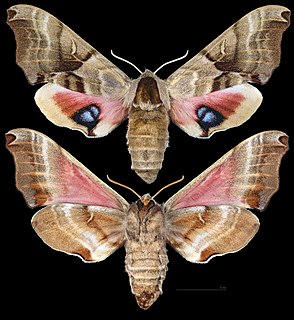
Smerinthus jamaicensis, the twin-spotted sphinx, is a moth of the family Sphingidae. The species was first described by Dru Drury in 1773.
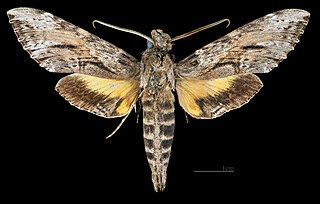
Isognathus rimosa, the rimosus sphinx, is a moth of the family Sphingidae. The species was first described by Augustus Radcliffe Grote in 1865.

Leptarctia is a monotypic tiger moth genus in the family Erebidae described by Stretch in 1872. Its only species, Leptarctia californiae, was described by Francis Walker in 1855. It is found in western North America, from New Mexico and Colorado to California and north to British Columbia. The habitat consists of open forests, meadows and clearings in the mountains.

Biblis hyperia, the red rim or crimson-banded black, is a species of brush-footed butterfly that is native to the lower Rio Grande Valley of Texas in the United States, Mexico, the Caribbean, Central America, and South America as far south as Paraguay. Its genus Biblis is so far monotypic, but at least one other undescribed species is suspected to exist.
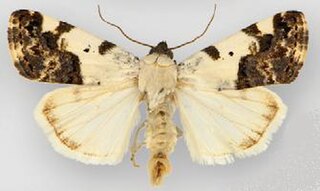
Tarache aprica, the exposed bird dropping moth, is a moth of the family Noctuidae. The species was first described by Jacob Hübner in 1808. It is found in North America from Ontario and Quebec to Florida, west to Arizona, north to Kansas and Iowa. There are some records from Great Britain, but this probably relates to imports.

Melitara dentata, the North American cactus moth, is a moth of the family Pyralidae. The species was first described by Augustus Radcliffe Grote in 1876. It is native to western North America, where it is widespread from Alberta to southern Arizona and central Texas. It is an introduced species in Hawaii.

Anavitrinella pampinaria, the common gray, is a moth of the family Geometridae. The species was first described by Achille Guenée in 1857. It is found in most of North America except the Arctic regions, south to Mexico.

Hesperumia latipennis is a moth of the family Geometridae first described by George Duryea Hulst in 1896. It is found in western North America from British Columbia south to California.
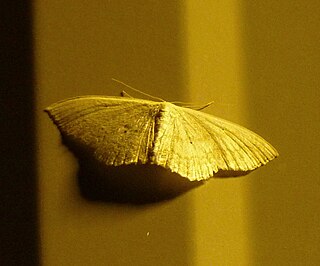
Lomographa glomeraria, the gray spring moth, is a moth of the family Geometridae. The species was first described by Augustus Radcliffe Grote in 1881. It is found in eastern North America, including Alabama, Arkansas, Illinois, Indiana, Maryland, Massachusetts, Michigan, Oklahoma, Ontario, Pennsylvania and Tennessee.
Cactobrosis fernaldialis, the blue cactus borer, is a species of snout moth in the genus Cactobrosis. It was described by George Duryea Hulst in 1886, and is found from Texas to southern California, where it inhabits deserts.
Eupithecia biedermanata is a moth in the family Geometridae first described by Samuel E. Cassino and Louis W. Swett in 1922. It is found in the US state of Arizona.
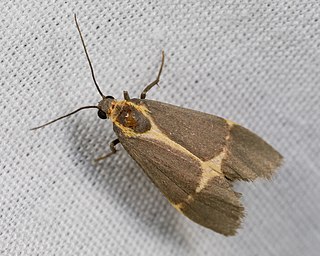
Cisthene barnesii, or Barnes' lichen moth, is a moth of the family Erebidae. It was described by Harrison Gray Dyar Jr. in 1904. It is found in the US Rocky Mountain region, from southern Montana and western North Dakota to the border with Mexico in Arizona and New Mexico. The habitat consists of dry bunchgrass steppe.

Elophila gyralis, the waterlily borer moth, is a moth in the family Crambidae. It was described by George Duryea Hulst in 1886. It is found in eastern North America, where it has been recorded from Alabama, Florida, Georgia, Illinois, Indiana, Iowa, Louisiana, Maine, Maryland, Massachusetts, Michigan, Minnesota, Mississippi, New Brunswick, New Hampshire, New Jersey, New York, North Carolina, Nova Scotia, Ohio, Oklahoma, Ontario, Pennsylvania, Quebec, South Carolina, Tennessee, Texas and Wisconsin.
Donacaula unipunctellus is a moth in the family Crambidae. It was described by Robinson in 1870. It is found in North America, where it has been recorded from Nova Scotia, Alabama, Florida, Georgia, Louisiana, Maine, Mississippi, New Jersey, New York, North Carolina, South Carolina, Texas, Utah and Virginia.

Pyromorpha dimidiata, the orange-patched smoky moth, is a species of leaf skeletonizer moth of the family Zygaenidae found in eastern North America.

Callizzia is a genus of scoopwing moths of the family Uraniidae. The genus was described by Packard in 1876. The adults' hindwings are sharply creased, forming a scoop shape. There are two species in the genus. The gray scoopwing moth is the type species of the genus, and the type specimen was collected in Albany, New York, in the United States.
Frechinia laetalis is a moth in the family Crambidae. It was described by William Barnes and James Halliday McDunnough in 1914. It is found in North America, where it has been recorded from eastern Washington and Oregon to Utah, southern California and western Texas.
Penestola bufalis, the black penestola moth, is a moth in the family Crambidae. It was described by Achille Guenée in 1854. It is found in the US states of Texas and Florida, as well as on the Antilles. It is an accidentally introduced species on the Galápagos Islands. The habitat consists of coastal mangrove swamps and shorelines.

Callizzia certiorara is a species of scoopwing moth in the family Uraniidae. It is found in North America.















